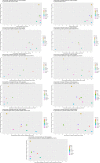Status of water, sanitation, and hygiene and standard precautions in healthcare facilities and its relevance to COVID-19 in Afghanistan
- PMID: 35289319
- PMCID: PMC9093622
- DOI: 10.1265/ehpm.21-00272
Status of water, sanitation, and hygiene and standard precautions in healthcare facilities and its relevance to COVID-19 in Afghanistan
Abstract
Background: To protect the health and safety of healthcare workers (HCWs), it is essential to ensure the provision of sustainable water, sanitation, and hygiene (WASH) services and standard precautions in healthcare facilities (HCF). The objectives of this short communication were 1) to assess the availability of WASH services and standard precautions in HCFs in seven provinces in Afghanistan before the COVID-19 pandemic, and 2) to elucidate the relevance of these patterns with the number of reported HCW infections from COVID-19 in the mentioned provinces.
Methods: We analyzed secondary data from the 2018-19 Afghanistan Service Provision Assessment survey, which included 142 public and private HCFs in seven major provinces in Afghanistan. Data on COVID-19 cases were obtained from the Afghanistan Ministry of Public Health Data Warehouse. Weighted prevalence of WASH services and standard precautions were calculated using frequencies and percentages. ArcGIS maps were used to visualize the distribution of COVID-19 cases, and scatter plots were created to visualize the relevance of WASH services and standard precautions to COVID-19 cases in provinces.
Results: Of the 142 facilities surveyed, about 97% had improved water sources, and over 94% had improved toilet for clients. Overall, HCFs had limited availability of hygiene services and standard precautions, which was lower in private than public facilities. More than half of the facilities had safe final disposal and appropriate storage of sharps and medical waste. Of the seven provinces, Herat province had the highest cumulative COVID-19 case rate among HCWs per 100,000 population and reported lower availability of WASH services and standard precautions in HCFs compared to other provinces.
Conclusion: Our findings show disparities in the availability of WASH services and standard precautions in public and private facilities. Private facilities had a lower availability of hygiene services and standard precautions than public facilities. Provinces with higher availability of WASH services and standard precautions in HCFs had a lower cumulative COVID-19 case rate among HCWs per 100,000 population. Pre-pandemic preparation of adequate WASH services and standard precautions in HCFs could be potentially important in combating infectious disease emergence.
Keywords: COVID-19; Hygiene; Sanitation; Standard precautions; Water.
Conflict of interest statement
The authors have no conflicts of interest.
Figures





Similar articles
-
Assessment of water, sanitation and hygiene service availability in healthcare facilities in the greater Kampala metropolitan area, Uganda.BMC Public Health. 2020 Nov 23;20(1):1767. doi: 10.1186/s12889-020-09895-9. BMC Public Health. 2020. PMID: 33228619 Free PMC article.
-
Access to water, sanitation and hygiene services in health facilities in sub-Saharan Africa 2013-2018: Results of health facility surveys and implications for COVID-19 transmission.BMC Health Serv Res. 2021 Jun 25;21(1):601. doi: 10.1186/s12913-021-06515-z. BMC Health Serv Res. 2021. PMID: 34172045 Free PMC article.
-
Using the Water and Sanitation for Health Facility Improvement Tool (WASH FIT) in Zimbabwe: A Cross-Sectional Study of Water, Sanitation and Hygiene Services in 50 COVID-19 Isolation Facilities.Int J Environ Res Public Health. 2021 May 25;18(11):5641. doi: 10.3390/ijerph18115641. Int J Environ Res Public Health. 2021. PMID: 34070423 Free PMC article.
-
Assessment of water, sanitation and hygiene in HCFs: which tool to follow?Rev Environ Health. 2019 Dec 18;34(4):435-440. doi: 10.1515/reveh-2019-0001. Rev Environ Health. 2019. PMID: 31265433 Review.
-
When It Is Not Measured, How Then Will It Be Planned for? WaSH a Critical Indicator for Universal Health Coverage in Kenya.Int J Environ Res Public Health. 2020 Aug 8;17(16):5746. doi: 10.3390/ijerph17165746. Int J Environ Res Public Health. 2020. PMID: 32784498 Free PMC article.
Cited by
-
Analysis of water, sanitation, and hygiene facilities using the WASH-FIT approach and its relation to patient satisfaction and maternal mortality at hospitals in Indonesia.Front Public Health. 2024 Feb 1;12:1322470. doi: 10.3389/fpubh.2024.1322470. eCollection 2024. Front Public Health. 2024. PMID: 38362217 Free PMC article.
-
Conflict-related environmental damages on health: lessons learned from the past wars and ongoing Russian invasion of Ukraine.Environ Health Prev Med. 2022;27:35. doi: 10.1265/ehpm.22-00122. Environ Health Prev Med. 2022. PMID: 36058871 Free PMC article.
-
Water, sanitation and hygiene (WASH) index for primary healthcare facilities: Towards achieving WASH security.Heliyon. 2024 Aug 2;10(15):e35548. doi: 10.1016/j.heliyon.2024.e35548. eCollection 2024 Aug 15. Heliyon. 2024. PMID: 39166035 Free PMC article.
References
-
- World Health Organization (WHO). Water, sanitation, hygiene, and waste management for SARS-CoV-2, the virus that causes COVID-19: interim guidance, WHO/COVID-19/IPC_WASH/2020.4). WHO. 2020. https://www.who.int/publications/i/item/WHO-2019-nCoV-IPC-WASH-2020.4. Accessed 28 Oct 2020.
-
- Cronk R, Bartram J. Environmental conditions in health care facilities in low- and middle-income countries: Coverage and inequalities. Int J Hyg Environ Health. 2018;221:409–22. - PubMed
-
- World Bank Group. WASH (Water, Sanitation & Hygiene) and COVID-19. 2020. https://www.worldbank.org/en/topic/water/brief/wash-water-sanitation-hyg.... Accessed 3 Dec 2021.
-
- Allegranzi B, Nejad SB, Combescure C, Graafmans W, Attar H, Donaldson L, et al.. Burden of endemic health-care-associated infection in developing countries: systematic review and meta-analysis. Lancet. 2011;377:228–41. - PubMed
-
- Adams J, Bartram J, Chartier Y, editors. Essential environmental health standards for health care. 2008. https://apps.who.int/iris/handle/10665/43767. Accessed 29 Jul 2020.

